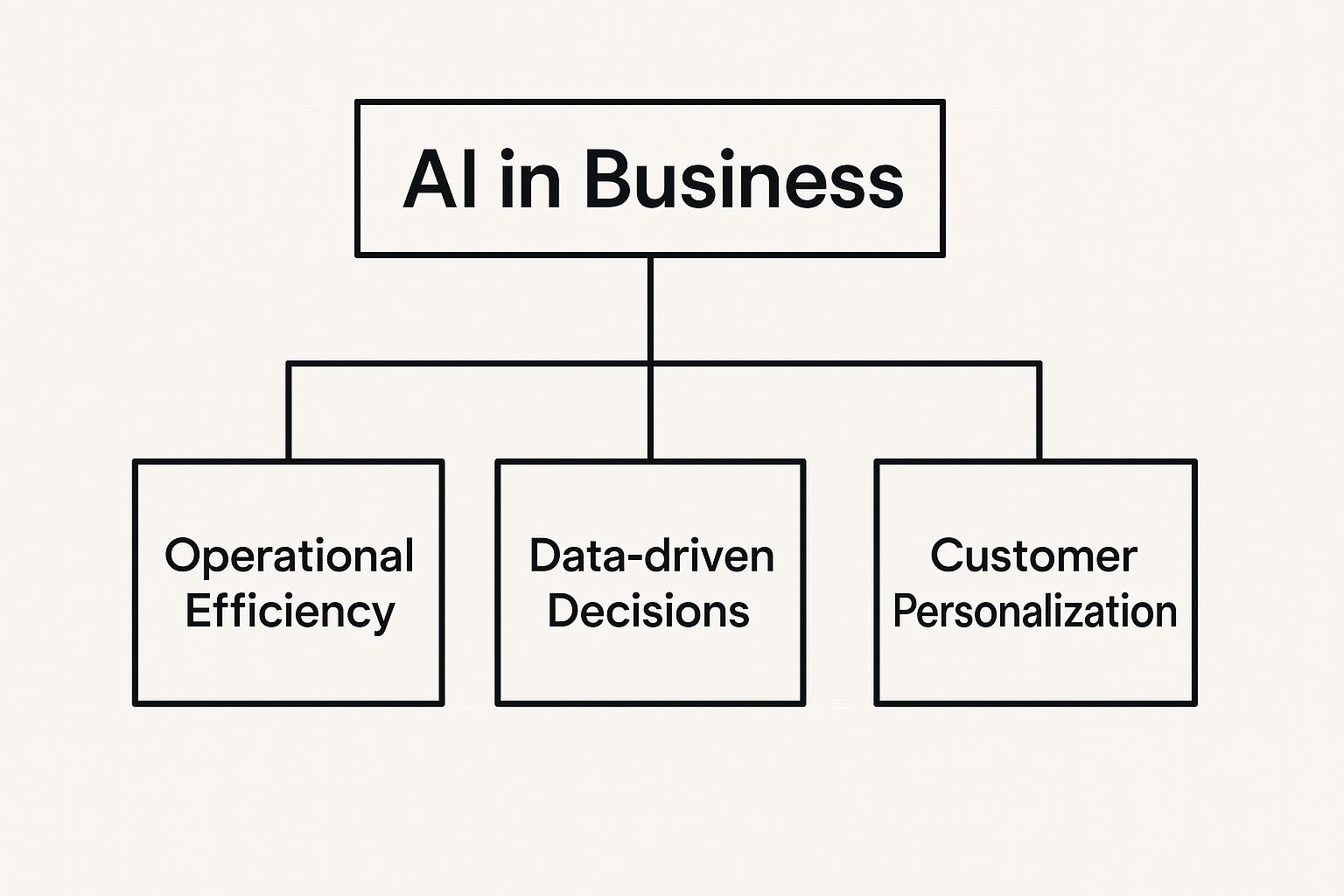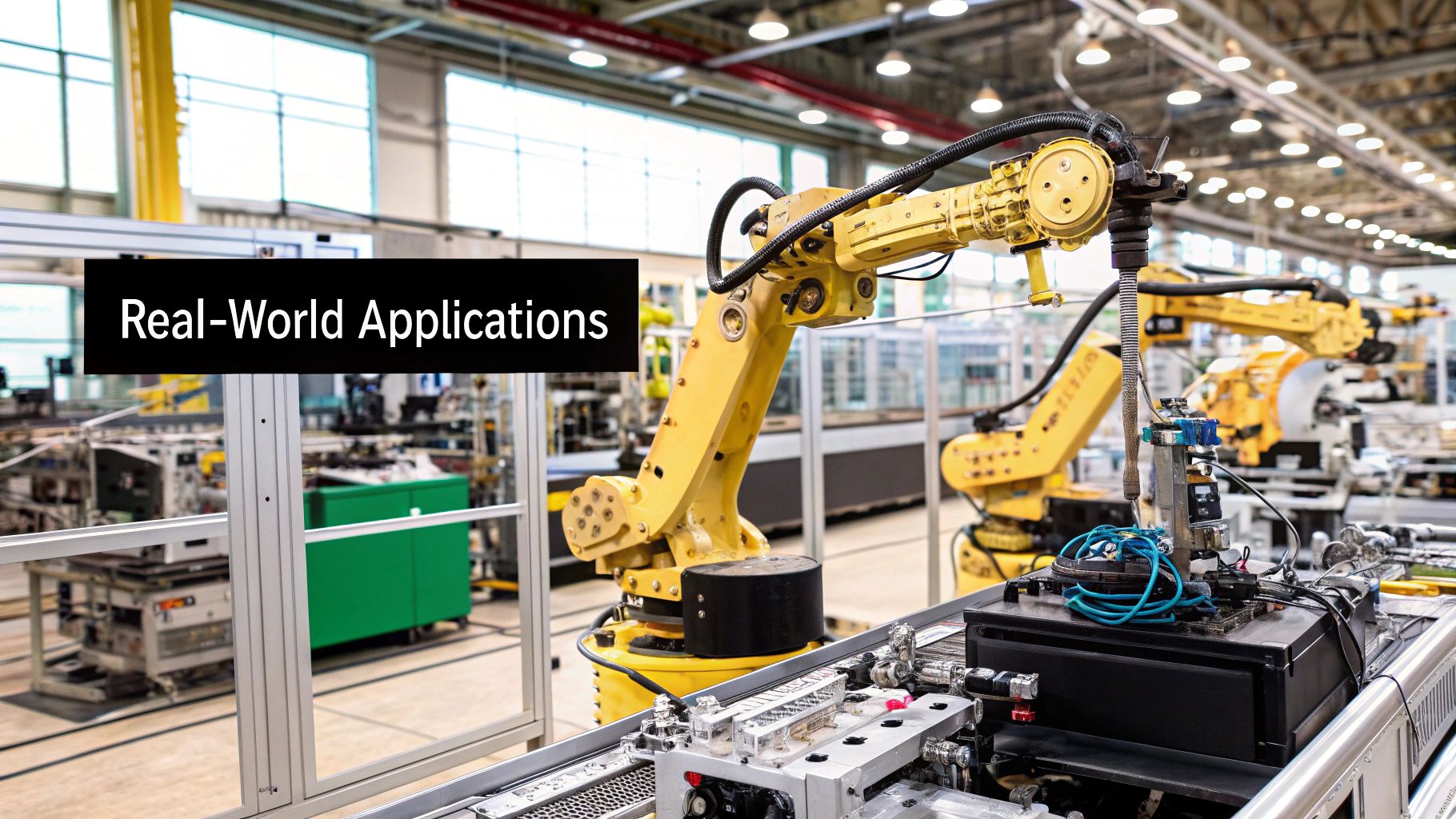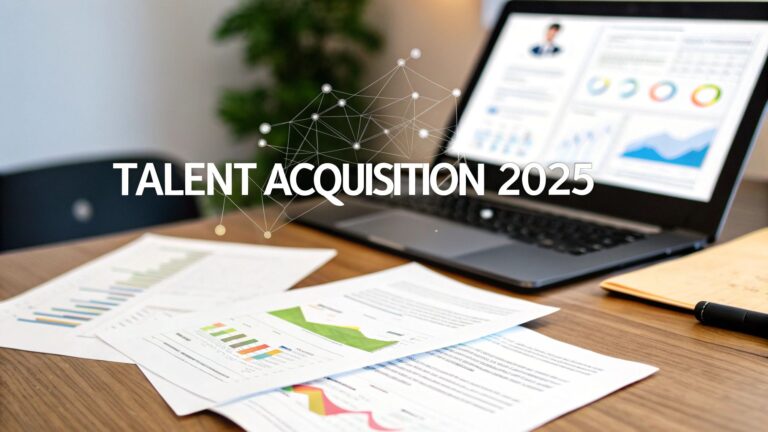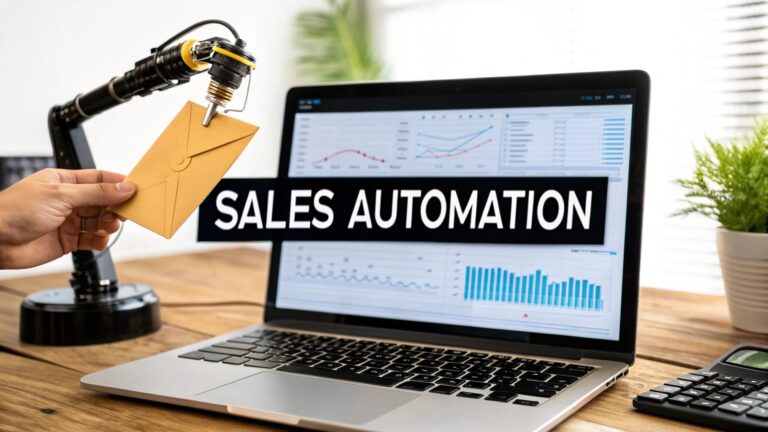What is AI in Business? Boost Efficiency & Growth Today
When we talk about artificial intelligence in business, we're really talking about using smart software to handle tasks that normally need a human brain. It’s not about replacing your team. It’s about giving each person a super-powered assistant—one that can chew through repetitive work, make sense of complex data, and sharpen decision-making.
What AI in Business Actually Means
Let's cut through the noise. Forget the sci-fi image of robots taking over the boardroom. "AI in business" is much more practical. It's about deploying a team of hyper-efficient digital specialists across your company, each designed to complement your human workforce and unlock new growth.
The whole point is to work smarter, not just harder. By automating the tedious stuff and uncovering insights buried in your data, you free up your people to focus on what they do best: thinking strategically, being creative, and building genuine customer relationships.
Your New Digital Specialists
To really grasp what AI in business is, it helps to meet a few of these digital "specialists" and see what they're capable of:
- The Data Analyst: This is Machine Learning (ML). Think of it as an AI that can comb through mountains of sales figures, customer reviews, and market trends to spot patterns and forecast what's coming next with impressive accuracy.
- The Communications Expert: This is Natural Language Processing (NLP). It's the engine behind smart chatbots that offer 24/7 customer support or the systems that can read, categorize, and summarize thousands of emails in the time it takes to grab a coffee.
- The Quality Inspector: This is Computer Vision. Imagine an AI that visually scans products on an assembly line, catching microscopic defects that a human eye would miss, ensuring every item that goes out the door is perfect.
These aren't futuristic concepts; they're becoming essential tools for modern business. This visual breaks down how these different capabilities support the core goals of using AI.

As you can see, it all comes down to making operations run smoother, helping you make smarter decisions, and creating more personal, meaningful customer experiences.
To give you a clearer picture, here’s a quick summary of how these capabilities directly impact different parts of a business.
How AI Transforms Core Business Functions
| AI Capability | Business Impact Area | Example Transformation |
|---|---|---|
| Machine Learning (ML) | Sales & Marketing | Predicting which customers are most likely to buy, allowing for highly targeted campaigns. |
| Natural Language Processing (NLP) | Customer Service | Analyzing customer emails and chat logs to understand sentiment and identify recurring issues instantly. |
| Computer Vision | Operations & Manufacturing | Monitoring assembly lines for product defects or safety hazards in real-time. |
| Generative AI | Content Creation | Drafting initial versions of marketing copy, social media posts, or internal reports for human refinement. |
| Predictive Analytics | Finance & Strategy | Forecasting revenue and cash flow with greater accuracy by analyzing historical data and market signals. |
This table just scratches the surface, but it shows the tangible ways AI can be put to work across an entire organization.
The Accelerating Pace of Adoption
This isn't just a niche trend; it's a full-blown movement happening incredibly fast. Recent data reveals AI adoption is expected to hit 72% among businesses by 2025, a massive leap from just a few years ago. Even more telling, 92.1% of companies already using AI report seeing measurable returns.
With the industry projected to grow at a blistering 37.3% compound annual rate through 2030, it’s no wonder that 83% of companies now consider AI a top strategic priority.
At its heart, business AI is about one thing: using intelligent systems to create tangible value. It’s the bridge between raw data and better outcomes, from happier customers to a healthier bottom line.
Ultimately, bringing these systems into your workflow is about building a more adaptable and competitive organization. By exploring the powerful connection between AI automation for business, companies are finding incredible new ways to improve how they work and speed up their growth.
What Are the Real-World Benefits Driving AI Adoption?

The rush to bring AI into the business world isn't about chasing the latest tech trend. It's a practical response to the very real, bottom-line benefits it delivers. Companies are investing because AI solves genuine problems and opens up new avenues for growth, turning raw data into a real competitive advantage.
At its heart, artificial intelligence injects a new layer of smarts into how a business operates. Think of it as a powerful force multiplier for your team, letting them get more done without getting bogged down by repetitive, low-value work. This fundamental shift from manual grunt work to intelligent automation is what’s really fueling its widespread adoption.
Boosting Productivity and Efficiency
One of the first things you'll notice with AI is its knack for automating tedious tasks. Just think about the hours your team loses to manual data entry, sorting through customer support emails, or pulling together the same weekly reports. AI can chew through these jobs with incredible speed and accuracy.
This frees up your talented people to focus on the bigger picture—the strategic work that truly requires human creativity and insight. When an AI can pre-qualify sales leads or organize project files, your team can spend their energy closing deals and innovating. It's a simple equation: a more efficient workflow where human talent is used for what it does best.
AI doesn't just cut costs by taking over mundane tasks; it changes the very nature of work. It empowers people to make a more meaningful impact, which is a key reason why understanding what is AI in business has become so crucial for modern leaders.
Sharpening Decision-Making with Data
Every company is sitting on a mountain of data. The problem is, most of that value remains locked away without the right tools to make sense of it all. AI is the key. It acts as a powerful analytical engine, sifting through massive datasets to find hidden patterns, forecast trends, and deliver the insights you need to make smarter, faster decisions.
For instance, an AI model can look at past sales figures, current market conditions, and even social media chatter to predict demand for a new product. This allows leaders to make crucial inventory and marketing calls based on hard evidence, not just gut feeling.
This data-driven approach has a few clear advantages:
- Real-Time Insights: Forget waiting on quarterly reports. AI delivers up-to-the-minute analysis, letting you adjust your strategy on the fly.
- Reduced Bias: By focusing purely on the data, AI helps strip away the unconscious human biases that can lead to poor judgment, resulting in more objective and reliable choices.
- Predictive Power: AI doesn't just tell you what happened. It helps you anticipate what will happen, from potential supply chain hiccups to shifts in customer preferences.
This ability turns decision-making from a reactive exercise into a proactive strategy. It gives leaders the foresight to get ahead of market changes and grab opportunities before the competition even knows they exist. That's the practical power of AI in action.
Seeing AI at Work in Your Organization

The real power of AI in business clicks into place when you see how it solves real-world problems. This isn't some far-off, abstract idea. It’s a practical tool that's already making a difference in just about every department you can think of. Let’s take a quick tour through a typical company to see exactly what that looks like.
Make no mistake, this is already happening. A recent global survey found that by early 2025, a staggering 78% of companies were already using AI in at least one part of their business. The most popular spots to find it are in IT, marketing, and sales, with the average company putting AI to work in three different areas. It’s clear that AI is quickly becoming a core part of how business gets done.
Boosting Marketing and Sales
In marketing, AI is like having a master strategist on your team, one that can personalize customer experiences on a massive scale. Forget one-size-fits-all campaigns. AI digs into individual customer behavior to show them the right message at the perfect moment.
It can also predict which sales leads are most likely to turn into customers, helping your sales team focus their efforts where they’ll have the biggest impact.
For example, this might mean:
- Dynamic Content: An online store showing an ad for hiking boots to a visitor who was just looking at waterproof jackets.
- Lead Scoring: Automatically ranking new leads by how engaged they are, so sales reps know who to call first.
A New Era for Customer Service
For customer service teams, AI is a game-changer for handling questions quickly and accurately. We've all seen intelligent chatbots, which offer instant, 24/7 help for common things like checking an order status or resetting a password. This frees up your human agents to handle the trickier, more nuanced customer problems that require a personal touch.
But it goes beyond just chatbots. AI tools can also perform sentiment analysis, scanning customer emails, chat transcripts, and social media posts to get a feel for how people are feeling. This gives you a live look at customer happiness, letting you jump on potential problems before they get out of hand.
When AI handles the predictable tasks, it allows your team to deliver amazing service when it counts the most. Your support center stops being just a cost and starts building real customer loyalty.
Fine-Tuning Operations and Finance
Over in the operations department, AI is a huge help with things like predictive maintenance. By analyzing data from factory equipment, it can actually predict when a machine is likely to break down before it happens, preventing expensive delays. It also fine-tunes entire supply chains by forecasting demand and figuring out the smartest, fastest shipping routes.
At the same time, the finance team is using AI to catch fraudulent transactions as they happen. These systems are brilliant at spotting strange patterns in data that a person might miss, saving companies from major financial hits and keeping customer accounts safe.
As another great example of AI at work, think about its impact on human resources. This guide on AI for Talent Acquisition explains how these tools can sift through thousands of résumés in minutes to find the best-fit candidates, making the hiring process faster and more effective. As you can see, the value of AI isn't just theoretical—it’s tangible and specific to the work your teams do every day.
How AI Becomes a True Economic Engine

Sure, cutting costs and making your teams more efficient are great benefits. But the real game-changer with AI is its power to directly generate new revenue and fuel serious growth. It’s not just about saving money; it’s about making more.
This is where the mindset shifts. When you see AI as a core driver of financial success, it stops being just another tool and becomes a central part of your strategy. By weaving intelligent systems into your operations, you can find new ways to boost customer value, fine-tune pricing, and spot opportunities you never would have seen otherwise.
Driving Revenue and Customer Value
One of the clearest ways AI boosts the bottom line is through a deeply personalized customer experience. Take the product recommendation engines on e-commerce sites. They aren't just guessing; they’re using AI to analyze a shopper's clicks, views, and past purchases to suggest other items they're almost certain to love.
This does more than just bump up the value of one sale. It makes the entire shopping trip feel more relevant and helpful, which builds loyalty and increases customer lifetime value (CLV). It’s a smart loop: better interactions lead straight to more revenue.
Dynamic pricing is another powerful example. AI can look at real-time market demand, what competitors are charging, and your own inventory levels to adjust prices on the fly. This helps you get the most out of every sale without scaring off customers—a tough balancing act to get right on your own.
AI transforms business from a game of guesswork into a science of growth. It provides the data-backed insights needed to make strategic financial decisions that directly impact revenue, profitability, and competitive standing.
Uncovering New Market Opportunities
Beyond just improving what you already do, AI is an incredible market analyst. It can dig through mountains of industry reports, social media chatter, and economic data to find profitable new niches or needs that are just starting to bubble up. This lets you get ahead of the curve, creating new products or services before your competitors even know what’s happening.
The economic impact here is impossible to ignore. On a global scale, projections suggest AI could pump over $15.7 trillion into the economy by 2030. In the U.S. alone, the market is expected to grow at a compound annual rate of nearly 27% through 2031. This isn't just some tech trend; it's a fundamental economic shift.
Once you’ve explored these financial benefits, it's worth seeing how they connect with operational improvements. You can discover 10 proven strategies to boost business efficiency with automation to see how these concepts fit together. In the end, understanding AI in business means seeing it for what it is: a true engine for economic growth.
Your Practical Roadmap for AI Implementation
Bringing artificial intelligence into your business can feel like a massive undertaking, but it doesn't have to be. The best way to approach it is with a clear, step-by-step plan. Forget about overhauling everything at once. Success comes from a series of smart, deliberate moves.
The first step is always to find the right problem to solve. Where are the bottlenecks in your business? Look for those repetitive, soul-crushing tasks that bog down your team, or areas where better data could lead to dramatically better decisions. A process that’s both a headache for your staff and a drain on revenue is usually the perfect place to start.
Start with a Focused Pilot Project
Instead of trying to launch a huge, company-wide AI initiative right out of the gate, kick things off with a small, manageable pilot project. Think of it as your proof of concept. The goal is simple: deliver real, tangible value quickly, learn some important lessons, and build momentum with very little risk.
For example, you could start with an AI-powered chatbot to handle the top 10 most common customer service questions. It’s a self-contained project with a clear way to measure success—a drop in agent response times and a bump in customer satisfaction. Nailing a pilot project like this makes it infinitely easier to get everyone else on board for bigger, more ambitious AI plans down the road.
Prepare Your Data and Choose Your Tools
Data is the lifeblood of any AI system. Getting it ready is non-negotiable. This means making sure your data is clean, organized, and actually accessible. You don't need absolutely perfect data to get started, but you do need a solid foundation for the AI tool to learn from.
From there, you’ll hit the classic "build vs. buy" crossroads. Building a custom AI solution gives you total control, but it also demands serious in-house expertise, time, and money. For most companies, the smarter move is to buy an existing AI tool from a vendor that already specializes in your problem, whether that’s marketing, sales, or support. These platforms are built for faster, easier integration.
The goal isn't just to use AI; it's to weave intelligence into your existing workflows. A well-chosen tool should feel like a natural extension of your team, not another complicated system you have to babysit.
Develop a Clear Strategy
As you move from idea to action, it's crucial to put your plans into a solid business framework. Thinking through the details by leveraging an AI business plan generator can help you map out your strategy and ensure every part of the initiative is covered. This process connects your AI goals directly to your core business objectives right from the start.
Scale, Manage, and Refine
Once your pilot project delivers a win, it's time to think bigger. Take what you learned and apply it to larger challenges or even different departments. After automating basic customer questions, maybe the next step is using AI to analyze customer sentiment across all your support channels.
This is also where change management becomes key. You have to communicate the why behind the new tech to your team. Frame it as a tool that helps them do their jobs better, not something that’s there to replace them. After all, great implementation is just as much about people as it is about the technology itself.
If you're looking for more ways to improve your internal systems, you can learn how to streamline business processes and boost overall efficiency. By following a clear roadmap, you can take the mystery out of AI and turn its potential into a powerful, practical asset for your business.
Answering Your Top AI in Business Questions
As AI moves from a futuristic concept to a daily business tool, it's natural to have questions—and maybe even a little healthy skepticism. To move forward with confidence, you need straight answers to the things that are really on your mind.
Let's cut through the noise and tackle some of the most common questions business leaders are asking right now. My goal here is to skip the dense, technical jargon and give you practical insights you can actually use.
The Real Difference Between AI, Machine Learning, and Gen AI
You've probably heard these terms thrown around, often in the same sentence. While they're related, they aren't interchangeable. The easiest way to think about them is like a set of nesting dolls.
- Artificial Intelligence (AI) is the biggest, outermost doll. It represents the entire field of creating machines that can perform tasks normally requiring human smarts, like problem-solving or learning.
- Machine Learning (ML) is the next doll inside. It’s a specific approach to achieving AI. Instead of programming a machine with explicit instructions for every single task, you feed it tons of data and let it learn patterns on its own to make predictions or decisions.
- Generative AI (Gen AI) is the smallest doll in the set. This is a specialized type of machine learning that doesn't just analyze or predict—it creates something entirely new. Think of AI that can write an email, design an image, or even compose music.
So, when your company uses software to forecast sales based on past performance, that’s ML in action (which is a form of AI). When you use a tool to help draft social media posts, that's Gen AI (which is a type of ML, and therefore also AI). It all fits together.
Do I Need a Team of Data Scientists?
This is probably one of the biggest misconceptions holding companies back. Ten years ago, the answer might have been yes. Today? Absolutely not.
We're no longer in an era where you have to build every AI solution from the ground up. An enormous market of "off-the-shelf" AI tools has completely changed the game. Platforms you already use, like Salesforce or HubSpot, have incredibly powerful AI features built right in. You can tap into advanced analytics, chatbots, and content creation tools with a simple subscription, not an entire data science department. For most businesses, the smart play is to buy, not build.
The question isn't whether you can afford a team of data scientists. The real question is: what business problem can you solve today with an existing, affordable AI tool?
How Can Small Businesses Afford AI Solutions?
The good news is that AI isn't just for the big guys anymore. Affordability has improved dramatically as vendors have introduced tiered pricing and subscription models designed specifically for small and medium-sized businesses (SMBs). In many cases, the cost is on par with other software you're already paying for.
The secret is to focus on Return on Investment (ROI). Don't just buy AI for the sake of it; start with a tool that solves a clear, costly problem. For instance, if an AI-powered customer service bot costs $200 a month but frees up 10 hours of your team's time, it has already paid for itself. Look for the quick wins that have a direct financial benefit.
What Are the Biggest Ethical Risks to Consider?
This is a critical question, and one you absolutely should be asking. For most businesses, the main ethical hurdles fall into a few key categories:
- Data Privacy: You have to be crystal clear about what customer data you're collecting and how your AI systems are using it. Making sure your tools comply with regulations like GDPR isn't just a legal requirement—it's a matter of trust.
- Bias: AI models learn from the data they're given. If that data contains historical biases—like in old hiring records or loan applications—the AI can easily learn and even amplify those same prejudices. It's vital to work with reputable vendors who are transparent about how they fight bias in their models.
- Accountability: When an AI system gets something wrong, who's responsible? You need to have clear internal policies for who oversees AI-driven decisions, how you spot errors, and what the process is for correcting them.
Getting ahead of these risks isn't just about avoiding fines; it’s about building a foundation of trust with your customers and your own team.
Ready to stop wondering about AI and start putting it to work? The experts at MakeAutomation can help you pinpoint the best AI and automation opportunities hiding in your business. We offer hands-on support to create scalable processes that crush manual work, drive ROI, and accelerate your growth. Learn how MakeAutomation can transform your business today.







